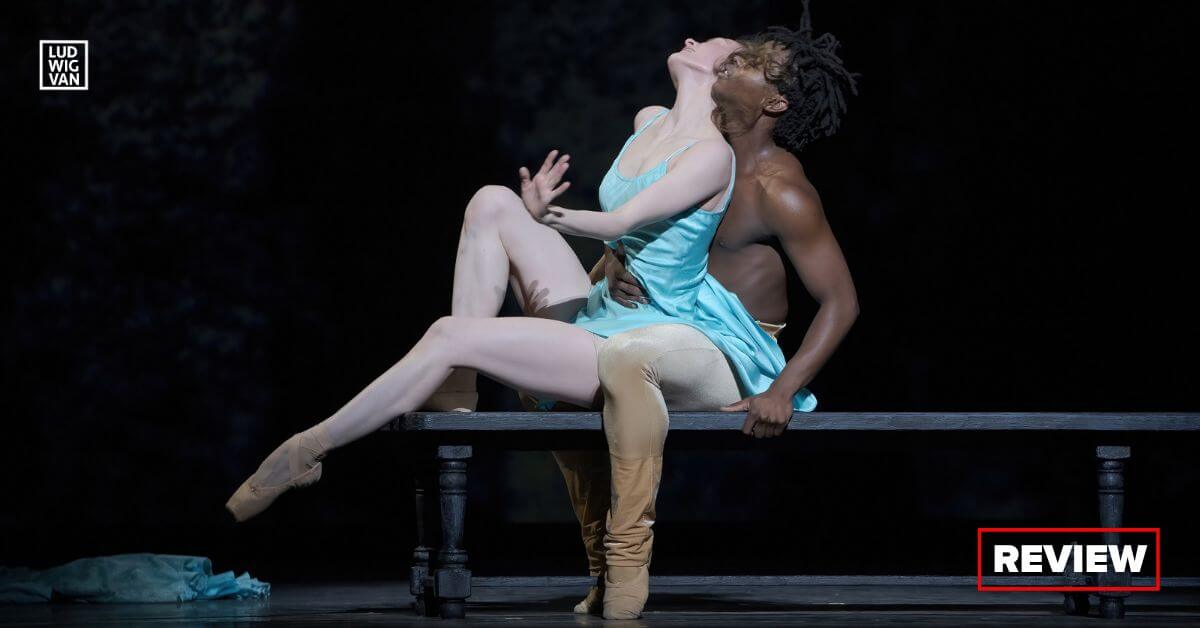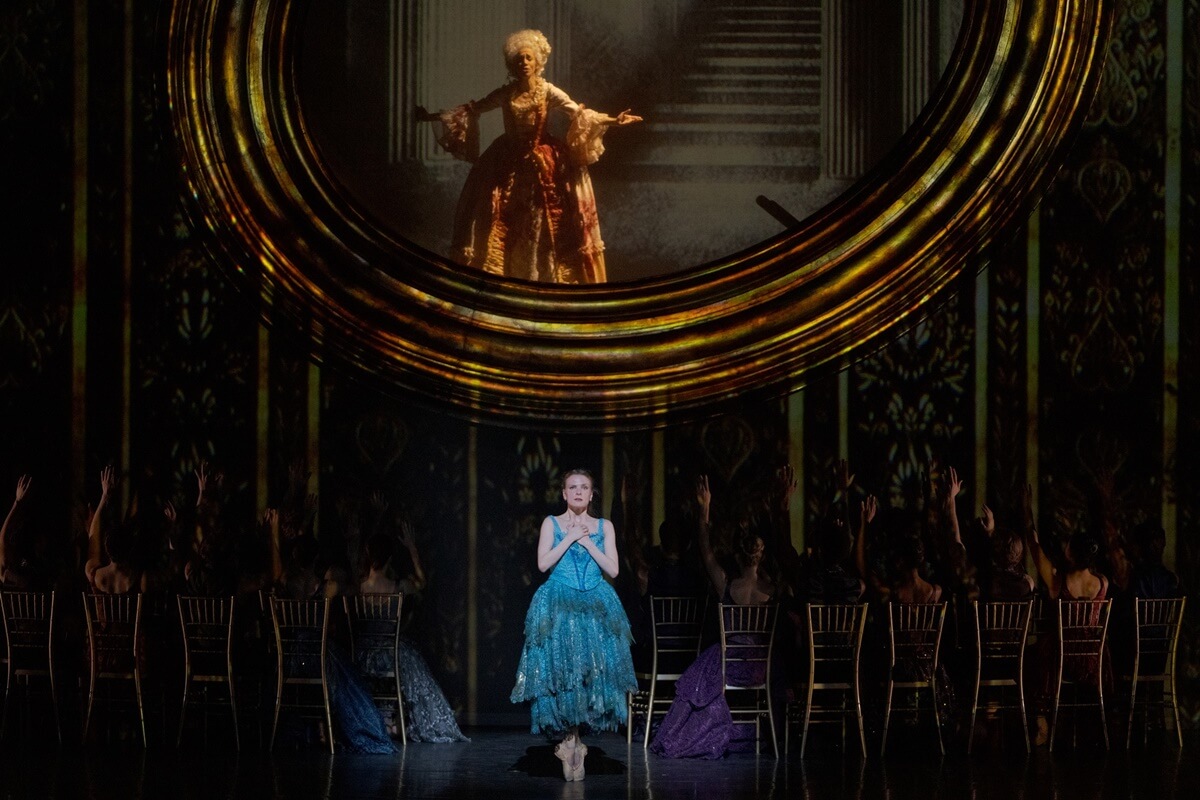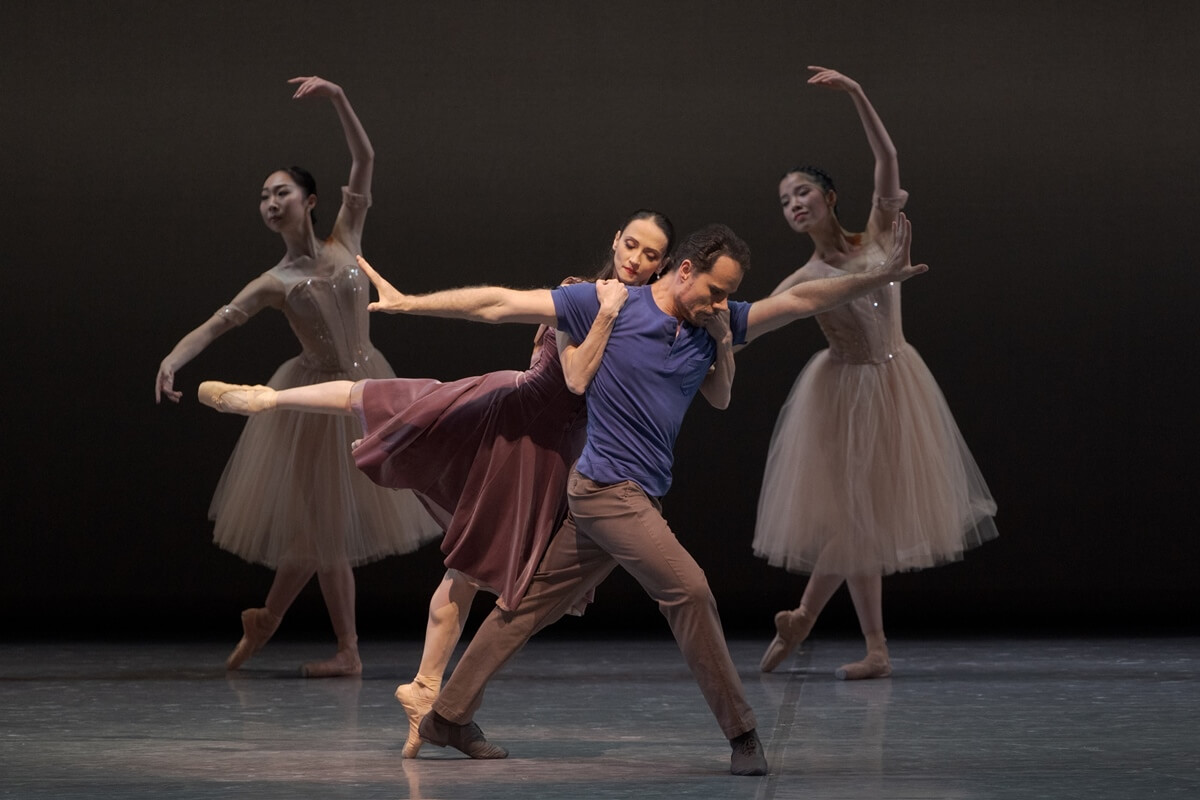
The National Ballet of Canada/Emma Bovary, choreographed by Helen Pickett & Passion, choreographed by James Kudelka, Four Seasons Centre, until Nov. 18. Tickets here.
The World Premiere of Emma Bovary by Helen Pickett
If you have read Madame Bovary, the 1856 novel by French author Gustave Flaubert, a classic of literary realism, you may have trouble with this new ballet, particularly the ending. If you are a Bovary virgin, so to speak, you will have a greater appreciation for this work. It’s a case of knowing too much will skewer expectations.
Helen Pickett is a renown American choreographer noted for her narrative works. For Emma Bovary, she collaborated with acclaimed British director James Bonas as both co-adapter, and co-director. The two had previously had a resounding success with The Crucible for Scottish Ballet in 2019.
The subtitle of Flaubert’s work is Provincial Manners which is an important feature in the novel. The beautiful and delicate Emma, who daydreams of a life of romance and luxury, is trapped in the stifling provincialism of small town bourgeois France.
The creators elected to concentrate on Emma (Hannah Galway), and her repressed sexuality. We also see the neglect of her child Berthe (a skeletal-looking puppet manipulated by Ross Allen, Emerson Dayton and Sophie Lee). A centrepiece is her feckless lover, Rodolphe Boulanger (Siphesihle November), and then there is her dull country doctor husband Charles (Donald Thom).
Padding the cast is Emma’s disapproving, stiff and cold mother-in-law, Madame Bovary (Jordana Daumec). Felicité (Tirion Law), is the Bovary’s maid. She seems to be included to show love to little Berthe, and passion with her boyfriend Justin (Alexander Skinner) — the passion that Emma does not have in her life. There is also L’Abbé (David Preciado) whose role is not very clear.
If Emma were alive today, she’s be Amazon’s best customer, because she is a shopaholic. Monsieur Lheureux (Spencer Hack), referred to in the program as a Fancy Good’s Salesman, is the evil merchant who satisfies her desire for luxury, a sublimation for her repression. His costume makes him look like the devil, as do his six-man sales team. We gather he is definitely evil, leading the Bovarys to debt and ruin.
Pickett is certainly able to make bodies tell stories, which is an art into itself. Right from the start, with the solo that begins the ballet, Galway’s tortured body speaks of her repressed sexuality and unhappiness. In fact, the movement for Emma throughout is the strongest feature of the ballet as we follow her many moods through her various encounters with people. This emotional role is Galway’s big break and she certainly rises to the occasion.
Also choreographically strong are Lheureux and his minions. Hack is a dancer who is quick and strong, and he overwhelms Emma with his force of personality. I do, however, have trouble that the luxury items that Emma buys are chairs. In fact, I had to stifle a laugh, because I find chairs very unromantic. At one point, Lheureux does show Emma a bolt of fabric, and, quite frankly, we needed more of the showy stuff. But chairs, really?
The passionate pas de deux for Galway and November is suitably ardent, but Rodolphe’s character is not well-defined overall. We needed to see him as a roué to give a reason for his abruptly ending the affair with Emma — her being just another conquest — but he is a cypher outside the relationship. In fact, Rodolphe’s portrait is a weakness, despite November’s many talents.

Another problem is that Thom as Charles comes across as a nice guy, where we should have seen a dullard. In narrative ballet, you sometimes have to exaggerate. As a contrast to Emma’s malaise, we needed a much more boring Charles. On the other hand, Daumec’s character as Charles’ mother is well-drawn; her disapproval of Emma, and her love for Berthe, read sharply. Daumec also plays an opera singer, another role that is ill-defined in the context of the storyline.
Tirion is pert and cute, as is Skinner, but why Pickett and Bonas have included Preciado’s L’Abbé is not clear. In the novel, Emma turns to religion at one point in her life, but why she is attending mass in the ballet is a mystery.
For me, one of the biggest problems is how Pickett and Bonas represent Emma’s moments of very strong emotions. They literally hoist her up in the air which was another suppressed laugh for me. I found the image just plain dumb. There is also the use of a cupboard, where things and people are put in and out, resulting in another amusing undertaking. In other words, there is a serious problem with metaphor.
The National has always been a company of dancing actors. Give them a strong character and they’ll run with it, and when Pickett does this, her skill as a narrative choreographer is well demonstrated. To her credit, there are other strong moments, like the ballroom scenes, and the end of the ballet when Emma’s world comes crashing in on her, as told through a swirl of moving furniture.
Production-wise, elements are strong.
Peter Salem’s original score is excellent. He is able to capture mood, and the motif of a ticking clock works well to express tedium. His swirling, romantic ballroom music, his menacing Lheureux sections, and his rapturous duet are wonderful. As they say, like hand to glove, score to story.
Michael Gianfrancesco’s costumes are period gorgeous, while his minimal set pieces, that move easily from scene to scene, shifted by dancers costumed in black, à la Japanese kuroko, enhance the action. The pièce de resistance is the huge centrepiece that at various time is a glittering chandelier or a gilded picture frame. It is a wonderful image of the longing for another life. Kudos also to Bonnie Beecher’s moody lighting, Grégoire Pont’s animation and Anouar Brissel’s projections, the latter two enlivening the back wall with abstract visions of inner turmoil.
As I have mentioned in the past, new ballets always need a second viewing, and I look forward to another go-round with Emma Bovary. Now that I know what I’m getting, I can set my expectations aside. Madame Bovary was simply one of the most depressing books that I have ever read, and this first time through, Pickett’s ballet did not hit me in the gut.

The Canadian Premiere of James Kudelka’s Passion
First of all, we have to acknowledge that this ballet was brought into the repertoire to celebrate the retirement of principal dancer Piotr Stanczyk. It was his choice to leave on a Kudelka piece, honouring the artistic director/choreographer who had been his mentor.
Kudelka created Passion for Houston Ballet in 2013 to great acclaim. To say that Stanczyk choose a winner is an understatement. Passion is quintessential Kudelka, meaning, there is more to see than the obvious. As a choreographer, Kudelka is positively subterranean in intent.
On one hand, you have a conventional tutu ballet reminiscent of Balanchine in its conceit. There is a lead couple (Harrison James and Calley Skalnik), two secondary couples who appear from time to time (Donald Thom and Chelsy Meiss, and Isaac Wright and Monika Haczkiewicz,), and a five-member female corps de ballet who should get a mention for their beautiful performance — Isabella Kinch, Clare Peterson, Ayano Haneishi, Miyoko Koyasu and Nio Hirano. Collectively, they all represent the quintessence of classical ballet and have technique up the whazoo.
Dennis Lavoie has costumed the woman in gorgeous soft pink tutus, and the men in attractive tights and tops. On the surface, you have the type of classical ballet that everyone loves because it is the perfect representation of the craft. Designer Michael Mazzola has lit the stage with the brightest light possible, so the dance literally pops off the stage.
And then there is Stanczyk and partner Svetlana Lunkina. Dressed in ordinary street clothes, they wander through the classical dancers, circling each other like animals intent on prey, until they finally connect in passionate partnering — all this to the highly romantic first movement of Beethoven’s Concerto for Piano. (If the music sounds familiar, it’s a transcription of the beloved violin concerto.)
First of all, each of the components can be stand-alone separate dance pieces, but Kudelka has chosen to put them together.
On the simple level, it is otherworldly romance contrasted with real world love. Stanczyk and Lunkina show a whole range of facial and body emotions while the classical crowd is frozen-faced. A further glance, however, reveals the contrast in the partnering. While everything about the classical dance is geared to beauty and grace, the contemporary couple are given moves that jar to a classical eye. She wraps her legs around him, for example; he grabs her by the belly. At several points, they even slow dance.
The classical component is an example of Kudelka’s tortuous movement. His classical ballet is harder than most because he packs so much into every phrase. Humorously, however, he has made the men the porters and the bearers of the women, as an homage to Russian tradition, but he does give the three men a section of their own where they can toss off showy danseur noble tricks. The classical dance is also packed with Kudelka’s famous swirling patterns, dizzying speed and cross-over near misses, so taken as whole cloth, you could say Passion is a celebration of classical ballet.
But — and this is a big but — there are the five ballerinas, who on the surface, do beautiful movement, enhancing the background of the three classical couples. If you look closely, however, their trajectory cuts through the couples, looking at times like a collision course. Then there is the bourée, the classical ballet term for walking on point. Kudelka has them do this several times and they seem like vacant-faced mechanical dolls, particularly because their arms are extended out to the side.
It is all very amusing, so, is this Kudelka laughing at ballet tradition in a gently mocking homage? Is it him showing that he can outdo Balanchine in entrances and exits? Is it him showing that he can outclass most choreographers when it comes to classical partnering? Is it Kudelka being abstract on steroids? Or is it Kudelka showing off?
What about the contemporary couple and the emotionally-laden performance of Stanczyk and Lunkina? Are they there to only show that Kudelka is also a master of contemporary ballet choreography? Or are they there to point out the overt silliness of classical ballet? Is it reality versus artifice?
All these questions! But that’s what a Kudelka piece does to the mind. I know that with each new viewing, more will be revealed.
Let us not forget to praise the cast both classical and contemporary. The dancing is simply glorious. And, of course, we give a fond farewell to Stanczyk, and thank him for 25-years of distinguished service. He will be missed.
Of course, there is the orchestra under Maestro David Briskin who gave another fine reading of both scores, and a special kudos to piano soloist Andrei Streliaev.
A Final Word About the Program
Here’s a question for you. Which would you rather know when you attend the ballet — the names of the production staff, or who is dancing?
Obviously, as a cost saving measure, the National has moved into the infamous QR codes to download the digital program. The company did, however, hand out a two piece cover that contained all the creative and production credits, as well as advertisements, but not so much as a word about the cast, or the fact that Stanczyk was retiring.
Were people pissed? You bet they were. This was a huge mistake on the part of the National.
By all means, hand out a simple two-pager, but at least opt for the names of the dancers.
Are you looking to promote an event? Have a news tip? Need to know the best events happening this weekend? Send us a note.
#LUDWIGVAN
Get the daily arts news straight to your inbox.
Sign up for the Ludwig Van Toronto e-Blast! — local classical music and opera news straight to your inbox HERE.
- INTERVIEW | Actor Diego Matamoros Takes On Icon Walt Disney In Soulpepper Production Of Hnath Play - April 16, 2024
- SCRUTINY | Opera In Concert Shine A Light On Verdi’s Seldom Heard La Battaglia Di Legnano - April 9, 2024
- SCRUTINY | Lepage & Côté’s Hamlet Dazzles With Dance And Stagecraft Without Saying Anything New - April 5, 2024



